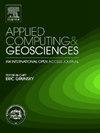SRT-Ai: Identifying seismic reflection terminations using deep learning
IF 3.2
Q2 COMPUTER SCIENCE, INTERDISCIPLINARY APPLICATIONS
引用次数: 0
Abstract
Seismic stratigraphy entails a regional scanning (reconnaissance) of seismic data to identify and annotate seismic reflection terminations. To identify these terminations in modern 3D seismic datasets, interpreters have to examine thousands of inlines and crosslines, which is a time-consuming process. Furthermore, accurate identification of these features relies heavily on human visual observation along with individual expertise.
A growing number of studies have shown promising results applying machine learning techniques to identify geological features from seismic data such as salt bodies and faults. However, the identification of seismic reflection terminations has not received the same level of interest and remains a manual process. One of the barriers to utilizing machine learning techniques in seismic interpretation is the lack of “labelled” data. In this study, we evaluate the ability of deep learning Convolutional Neural Networks (CNN) trained on synthetic seismic images to identify seismic reflection terminations.
A dataset comprising 160 000 synthetic seismic images that represent conformable and four types of seismic reflection terminations (truncation, toplap, onlap, and downlap) were created using geometric geological modelling and 1D convolution seismic modelling. The dataset was then split into two classes (“Contains Termination” and “No Termination”). A new CNN model architecture named “Seismic Reflection Terminations Attribute (SRT-Ai)” was trained on 80 % of the synthetic seismic dataset. SRT-Ai predicted the test set (remaining 20 %) with an accuracy and precision of 99.9 %. To test its generalization, SRT-Ai was also evaluated on real seismic images, achieving 91 % accuracy and 96 % precision against published interpretations used as reference labels. Qualitative analysis of predictions along seismic sections shows a strong correspondence between the model predictions and manual regional interpretations.
SRT-Ai is proposed as a screening tool that will assist seismic interpreters with the identification of major seismic terminations, minimise seismic interpretation uncertainties, reduce the time taken for seismic reconnaissance, and limit the reliance on human visual observation at the early stage of seismic interpretation process.
SRT-Ai:利用深度学习识别地震反射终端
地震地层学需要对地震数据进行区域扫描(侦察),以识别和注释地震反射终端。为了在现代三维地震数据集中识别这些端点,解释人员必须检查数千条内线和交线,这是一个耗时的过程。此外,这些特征的准确识别在很大程度上依赖于人类的视觉观察以及个人的专业知识。越来越多的研究表明,应用机器学习技术从地震数据中识别地质特征(如盐体和断层)取得了可喜的结果。然而,地震反射终端的识别并没有受到同等程度的关注,仍然是一个人工过程。在地震解释中使用机器学习技术的障碍之一是缺乏“标记”数据。在这项研究中,我们评估了在合成地震图像上训练的深度学习卷积神经网络(CNN)识别地震反射终止的能力。使用几何地质建模和一维卷积地震建模,创建了一个包含16万张合成地震图像的数据集,这些图像代表了四种类型的地震反射终端(截断、上覆、上覆和下覆)。然后将数据集分成两类(“包含终止”和“无终止”)。在80%的合成地震数据集上训练了一种新的CNN模型架构“地震反射终止属性(SRT-Ai)”。SRT-Ai预测测试集(剩余20%)的准确度和精密度为99.9%。为了验证其泛化性,SRT-Ai还在真实地震图像上进行了评估,与用作参考标签的已发表解释相比,准确率达到91%,精度达到96%。沿地震剖面预测的定性分析表明,模式预测与人工区域解释之间有很强的对应关系。SRT-Ai被认为是一种筛选工具,可以帮助地震解释人员识别主要的地震终端,最大限度地减少地震解释的不确定性,减少地震侦察所需的时间,并限制在地震解释过程的早期阶段对人类视觉观测的依赖。
本文章由计算机程序翻译,如有差异,请以英文原文为准。
求助全文
约1分钟内获得全文
求助全文
来源期刊

Applied Computing and Geosciences
Computer Science-General Computer Science
CiteScore
5.50
自引率
0.00%
发文量
23
审稿时长
5 weeks
 求助内容:
求助内容: 应助结果提醒方式:
应助结果提醒方式:


